Executive Summary
Sedimentation is a simple, physical pre-treatment of water prior to application of other purification treatments such as filtration and disinfection. It removes undesirable small particulate suspended matter (sand, silt and clay) and some biological contaminants from water under the influence of gravity. The longer the water is held undisturbed, the more the suspended solids and pathogens will settle to the bottom of the container. Adding coagulants can accelerate the sedimentation process. Three common chemicals used for this purpose are aluminium sulphate, polyaluminium chloride (also known as PAC or liquid alum) and ferric sulphate. Some native plants like prickly pear cactus, Moringa seeds, broad beans and Fava beans have all been traditionally used as natural coagulants to help sediment water in a number of countries in Africa and Latin America.
| In | Out |
|---|---|
Freshwater, Drinking Water |
Introduction
Plain sedimentation (also referred to as settlement or simple gravity sedimentation) is a simple, physical, low-cost pre-treatment of water prior to application of other purification methods such as filtration (e.g. slow sand filtration) and disinfection (e.g. chlorination, ozonation). It removes undesirable small particulate suspended matter (sand, silt and clay) and some biological contaminants from water under the influence of gravity. The longer the water is stored or hold undisturbed, the more the suspended solids and pathogens will settle to the bottom of the container. Adding coagulants can accelerate the sedimentation process.
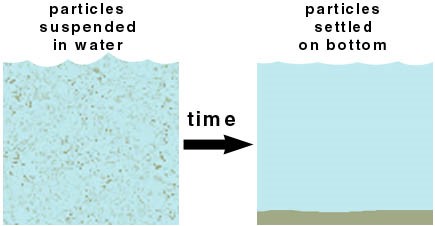
This factsheets focuses on sedimentation as a step in centralised water purification plants. For sedimentation as part of point of use water purification on household level see: Sedimentation (POU).
Working principle
The suspended particles in water vary considerably in source, composition, charge, particle size, shape and density. The smaller particles present in water are kept in suspension by the action of physical forces on the particles themselves. One of the forces playing a dominant role in stabilisation results from the surface charge present on the particles. Most solids suspended in water possess a negative charge and since they have the same charge sign, repel each other when they come close together. Therefore they will remain in suspension rather than clump together and settle. However, under the influence of gravity, larger particles will settle to the bottom and can be separated from the water. The optimal holding time depends on the initial turbidity and water quality requirements for subsequent treatment steps. This process is referred to as plain sedimentation or settlement.
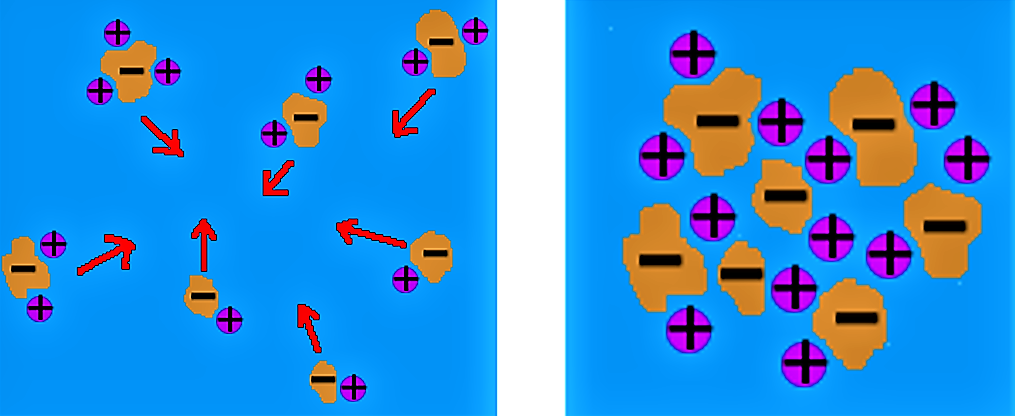
Adding chemical or natural coagulants to the water can quicken the sedimentation process. Aluminium sulphate, polyaluminium chloride (also known as PAC or liquid alum) and ferric sulphate are three common types of chemicals used for coagulation. Some examples of natural coagulants are prickly pear cactus, Moringa seeds, broad beans and Fava beans. Some products like “PUR” contain both coagulants and disinfectant. After sedimentation, the water should be filtered (e.g. slow sand filtration, rapid sand filtration, etc.) to further remove suspended materials and pathogens.
Basic design principle & technical installations
Most often, centralised sedimentation chambers form an integral part of a treatment cycle combining pure sedimentation with coagulation flocculation, filtration, disinfection and storage facilities. For more information on this treatment cycle on the household level, see: Household Water Treatment and Safe Storage HTWS.
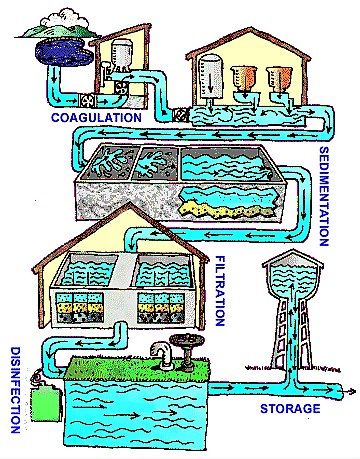
Sedimentation can be done by simply filling jars or tanks and holding the water undisturbed for a while and then decanting the water from the sediment. This process may be suitable for water treatment on a household level. For community or urban water supply, the sedimentation process needs to be operated continuously.
The design of sedimentation facilities for community or urban water supply range from simple, small sedimentation chambers to large, highly technological sedimentation basins. The former are often made of concrete rectangular tanks. Inflowing water horizontally passes one or more separated sub-chambers while more and more particles sediment.
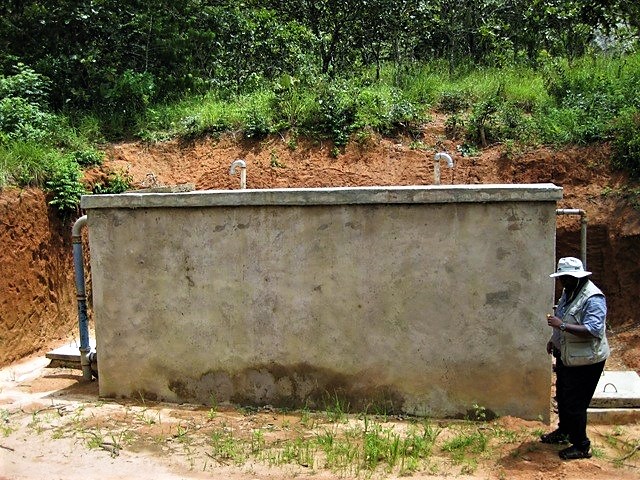
Large sedimentation basins are often round-shaped. The freshwater inlet is located in the centre of the basin from where the water radially flows to the circular outlet at the rim.
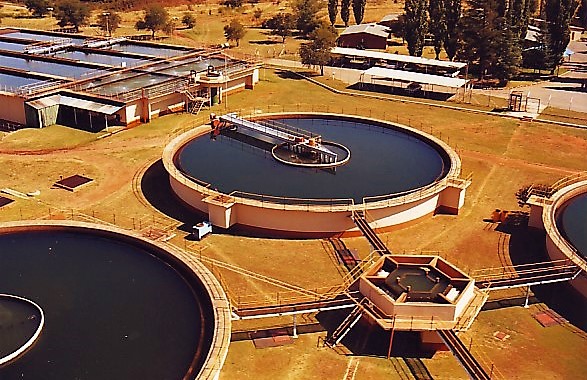
Costs
Water purification measures are associated with capital and operational costs. Many centralised water treatment plants in urban areas in developed countries are costly as they make use of high-end technology. However, effective treatment does not necessarily require such a level of investment. Simple sedimentation chambers are associated with very low construction costs. Equally, spending for operation and maintenance is minimal given the turbidity level of the initial water is not too high. Hereby, maintenance tasks mainly include interrupting the inflow, emptying the chamber and removing the settles material. However, the use of coagulants may be costly depending on water quality and the availability of required chemicals.
Health aspects
Plain sedimentation is very effective in reducing water turbidity, however, it is not consistently effective in reducing microbial contamination. Holding the water undisturbed for a few hours allows the larger, denser particles (e.g. sand, silt) to sediment. The longer the water remains motionless inside the sedimentation chamber, the more fine particles start to settle. Since many pathogens including bacteria, viruses, protozoa and helminths are attached to suspended particles, the reduction of turbidity also improves the microbiological quality (AMAGLOH & BENANG 2009). Removing turbidity comes along with an improved visual quality of the water and thus increases its acceptance by consumers.
Yet, very fine solids (i.e. clay) and most dispersed viruses and bacteria are too small to be settled by simple gravity sedimentation. For this reason, coagulants are used helping to effectively remove fine particles and to shorten the sedimentation process. The use of Moringa Oleifera seeds for water treatment is efficient in reducing 80% to 99.5% of turbidity accompanied by 90% to 99.99% bacterial reduction (LEA 2010).
|
| Viruses | Helminths | |||
| Laboratory | >90 - >99% | >90 - >99% | >90 - >99% | >90 - >99% | 80-99.5% |
| Field | <90% |
|
|
| 95% |
Summary of Treatment efficiency of sedimentation with the aid of natural & chemical coagulants. Adapted from CAWST (2009)
The effectiveness of coagulants has a complex dependence on the type of coagulant, the characteristics of the fresh water (e.g. temperature, pH, and the specific proportions of particles that constitute the suspended solids). The best approach for determining the treatability of a water source and determining the optimum parameters (i.e. the most effective coagulant, the required dose rates, pH) is by use of a jar tester. Plain sedimentation or settling is not effective for removing dissolved chemicals from the water.
Usually, purified water is either stored in tanks or fed into a distribution system before being consumed or utilised. In order to make sure water quality still meets drinking water standards after storage or distribution, sedimentation needs to be combined with further purification procedures. For this reason, filtration and chlorination is often applied even though water quality after purification is sufficient. The residual concentration of chlorine will also prevent the water from being re-contaminated.
In case of water purification in emergencies, filtration may be left out temporarily, however, chlorination has to be applied at all events.
At a glance
| Working principle | With or without adding coagulants, fresh water is let standing still in a chamber or basin until solid particles have settled to the bottom. |
| Capacity/adequacy | Can reduce turbidity to a level that further purification measures can efficiently deal with. |
| Performance | Depending on their size, sedimentation chambers can suit both rural and urban drinking water systems. |
| Costs | Low to high |
| Self-help compatibility | High without coagulation. Rather low with coagulation |
| Reliability | High, particularly with coagulants. |
| Main strength | Simple, physical process |
| Main weakness | Plain sedimentation is not sufficient as purification measure |
Effectiveness of Moringa Oleifera Seed as Coagulant for Water Purification
A research carried out to examine the effectiveness of powder extracted from mature dried Moringa oleifera seeds as a coagulant, which is commonly available in most rural communities of Africa. The results obtained showed that powder from seed kernels of Moringa Oleifera contains coagulating properties at loading doses of 10 g/L and above that have similar effect as the conventional coagulant, alum.
AMAGLOH, F.K. ; BENANG, A. (2009): Effectiveness of Moringa Oleifera Seed as Coagulant for Water Purification. URL [Accessed: 21.05.2019]Simple sedimentation tank
Treating the Public Water Supply: What Is In Your Water, and How Is It Made Safe to Drink?
Chemical Coagulants
A three-page factsheet containing information on treatment efficiency, operating criteria and other relevant information on chemical coagulants.
CAWST (2009): Chemical Coagulants. (= Household Water Treatment and Safe Storage Fact Sheets ). Calgary: Centre for Affordable Water and Sanitation Technology (CAWST) URL [Accessed: 21.05.2019]Water Treatment Cycle
Water Clarification using Moringa Oleifera Seed Coagulant
This technical brief gives an overview of the application of an indigenous, naturally derived coagulant, namely seed material from the multi-purpose tree Moringa Oleifera, which offers an alternative solution to the use of expensive chemical coagulants.
FOLKARD, G. SUTHERLAND, J. SHAW, R. (1998): Water Clarification using Moringa Oleifera Seed Coagulant. Loughborough (U.K.): Water and Environmental Health at London and Loughborough (WELL), Loughborough University, Technical Brief 60, pp.109-112 URL [Accessed: 21.05.2019]Bioremediation of Turbid Surface Water Using Seed Extract from Moringa Oleifera Lam. (Drumstick) Tree
Lesson 9: Colloids and Coagulation
Large, high-tech sedimentation basins
Review of Coagulation Technology for Removal of Arsenic: Case of Chile
This paper presents a summary of the process, concepts and operational considerations for the use of coagulation technology for removal of arsenic in Chile.
SANCHA, A. M. (2006): Review of Coagulation Technology for Removal of Arsenic: Case of Chile. In: Journal of Health, Population and Nutrition: Volume 24 , 267-272. URL [Accessed: 14.05.2012]Water Clarification Using Moringa oleifera
Technical information on water clarification using Moringa Oleifera, with preparation techniques of the coagulant solution, method of treatment, dosage, advantage and disadvantages of the natural coagulant with useful links.
SCHWARZ, D. (2000): Water Clarification Using Moringa oleifera. Eschborn: GATE-GTZ URL [Accessed: 21.05.2019]Aluminium in Drinking Water: an Overview
Guidelines for Drinking-water Quality, Third Edition
This volume of the Guidelines for Drinking-water Quality explains requirements to ensure drinking-water safety, including minimum procedures and specific guideline values, and how those requirements are intended to be used. The volume also describes the approaches used in deriving the guidelines, including guideline values. It includes fact sheets on significant microbial and chemical hazards.
WHO (2008): Guidelines for Drinking-water Quality, Third Edition. Third Edition incorporating the First and Second Addenda. Geneva: World Health Organization (WHO) URL [Accessed: 23.04.2012]Compendium of Sanitation Systems and Technologies (Arabic)
This is the Arabic version of the Compendium of Sanitation Systems and Technologies. The Compendium gives a systematic overview on different sanitation systems and technologies and describes a wide range of available low-cost sanitation technologies.
TILLEY, E. ULRICH, L. LUETHI, C. REYMOND, P. SCHERTENLEIB, R. ZURBRUEGG, C. (2014): Compendium of Sanitation Systems and Technologies (Arabic). 2nd Revised Edition. Duebendorf, Switzerland: Swiss Federal Institute of Aquatic Science and Technology (Eawag) PDFChemical Coagulants
A three-page factsheet containing information on treatment efficiency, operating criteria and other relevant information on chemical coagulants.
CAWST (2009): Chemical Coagulants. (= Household Water Treatment and Safe Storage Fact Sheets ). Calgary: Centre for Affordable Water and Sanitation Technology (CAWST) URL [Accessed: 21.05.2019]Natural Coagulants
A four-page factsheet containing information on treatment efficiency, operating criteria and other relevant information related to natural coagulants.
CAWST (2009): Natural Coagulants. (= Household Water Treatment and Safe Storage Fact Sheets ). Calgary: Centre for Affordable Water and Sanitation Technology (CAWST) URL [Accessed: 21.05.2019]Settling
A three-page factsheet containing introduction, operation procedure, treatment efficiency, operating criteria and other information related to settling.
CAWST (2009): Settling. (= Household Water Treatment and Safe Storage Fact Sheets ). Calgary: Centre for Affordable Water and Sanitation Technology (CAWST) URL [Accessed: 21.05.2019]Water Clarification using Moringa Oleifera Seed Coagulant
This technical brief gives an overview of the application of an indigenous, naturally derived coagulant, namely seed material from the multi-purpose tree Moringa Oleifera, which offers an alternative solution to the use of expensive chemical coagulants.
FOLKARD, G. SUTHERLAND, J. SHAW, R. (1998): Water Clarification using Moringa Oleifera Seed Coagulant. Loughborough (U.K.): Water and Environmental Health at London and Loughborough (WELL), Loughborough University, Technical Brief 60, pp.109-112 URL [Accessed: 21.05.2019]Arsenic Removal from Drinking Water During Coagulation
This paper presents the findings of a study on the efficiency of arsenic removal from source water and artificial freshwater during coagulation with ferric chloride and alum. They found that pH range for arsenic (V) removal with alum was more restricted than with ferric chloride and that arsenic (III) could not be removed from source water by coagulation with alum.
HERING, J.G. ; PEN-YUAN, C. ; WILKIE, J.A. ; ELIMELECH, M. (1997): Arsenic Removal from Drinking Water During Coagulation. In: Journal of Environmental Engineering: Volume 123 , 800-807. URL [Accessed: 14.05.2012]Smart Disinfection Solutions
This booklet, part of the Smart Water Solutions series provides a wide range of methods and products for home water treatment in rural areas.
NWP (2010): Smart Disinfection Solutions. Examples of small-scale disinfection products for safe drinking water. (= Smart water solutions ). Amsterdam: KIT Publishers URL [Accessed: 17.05.2019]Improving Filtrate Quality Using Agro based Materials as Coagulant Aid
This research assesses the agro based materials like Surjana seed (Moringa oleifera), Nirmali seed (Strychnos pototorum) and maize (Zeemays) as a coagulant aid in conjunction with alum to determine their efficacy in water treatment. Experiments have been conducted simulating a conventional water treatment train consisting of coagulation-flocculation-settling and granular media filtration. They found that filtrate quality has improved with the use of agro-based materials.
RAGHUWANSHI, P.K. ; MANDLOI, M. ; SHARMA, A.J. ; MALVIYA, H.S. ; CHAUDARI, S. (2002): Improving Filtrate Quality Using Agro based Materials as Coagulant Aid. In: Water Quality Research Journal of Canada: Volume 37 , 745-756. URL [Accessed: 24.05.2019] PDFMoringa as an Alternative to Aluminium Sulphate
This paper discusses different features of Moringa oleifera seed and assesses it as a potential alternative to aluminium sulphate for water treatment in rural and urban areas. Paper presented on 27th WEDC Conference in Lusaka, Zambia.
NKHATA, D. (2001): Moringa as an Alternative to Aluminium Sulphate. In: People and Systems for Water, Sanitation and Health. Papers of the 27th WEDC Conferences, Zambia: , 236-238. URL [Accessed: 21.05.2019]Review of Coagulation Technology for Removal of Arsenic: Case of Chile
This paper presents a summary of the process, concepts and operational considerations for the use of coagulation technology for removal of arsenic in Chile.
SANCHA, A. M. (2006): Review of Coagulation Technology for Removal of Arsenic: Case of Chile. In: Journal of Health, Population and Nutrition: Volume 24 , 267-272. URL [Accessed: 14.05.2012]Evaluating Coagulant for Water Treatment. Presentation
This document is an overview presentation on different coagulants, discussing different case studies with field results and some lessons learned. Presented in PNWS-AWWA Section Conference.
DUNCAN, K. WISE, D. (2008): Evaluating Coagulant for Water Treatment. Presentation. American Water Works Association, Pacific Northwest Section (PNWS-AWWA) URL [Accessed: 21.05.2019]Water/Wastewater Distance Learning Website
This weblink gives information on properties of colloids, their relationship with coagulation and effects of zeta potential on coagulation.
